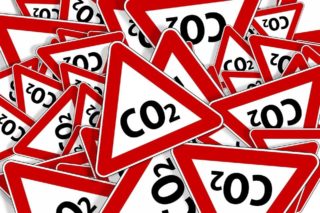-
CO2 levels hit record level in May (but what about Covid-19…?)
Date posted:
-
-
-
Post Author
Philip SharmanIFRF Director
-

Earlier this month, the US National Oceanic and Atmospheric Administration (NOAA) and the Scripps Institution of Oceanography at the University of California San Diego announced that the level of carbon dioxide in the atmosphere (as measured at the Mauna Loa Observatory in Hawai’i) reached a new seasonal record of 417.07 parts per million by volume in May, up from the previous seasonal record of 414.65ppm in May 2019, continuing its steady upward march. This rise – 0.58% – doesn’t sound worrying… but we need to see it in context.
Of the various greenhouse gases, CO2 is the most significant in terms of climate change, and the atmospheric concentration of man-made (‘anthropogenic’) CO2 has been rising steadily since the Industrial Revolution, particularly from the middle of the 20th century. The current level of over 417ppm compares with a stable, pre-industrial level of around 280ppm, maintained for at least the last 6000 years. Such a rate of increase and level of CO2 have not occurred in the natural system for at least 20 million years.
When I first got actively involved in climate change mitigation technologies such as CCS (over 20 years ago now!), the atmospheric level of CO2 was around 370ppm and we all talked optimistically (and unrealistically) about holding it to below 400ppm! I distinctly remember the 400ppm threshold being breached (albeit briefly) for the first time in 2014, and by May of 2015 the seasonal record stood at 400.51ppm. In the five years that have gone by since then, the May seasonal ‘high’ each year has risen by over 3.3ppm/year on average, and, at this rate of increase, we look set to breach 450ppm by about 10 years from now.
“Why”, I hear you ask, “are these higher thresholds important?”
Well, under the UN Paris Agreement, concluded in 2015, signatories are committed to holding the global average temperature increase well below 2°C by the end of the century and pursuing efforts to limit it to 1.5°C. Scientific advisors on the Intergovernmental Panel on Climate Change (IPCC) have estimated that these limits imply an atmospheric concentration of no more than 450ppm for 2°C or 430ppm for 1.5°C. The corollary of these estimates is that we have just 10 years at the current rate of increase of CO2 in the atmosphere before we reach the point where we get locked-in to potentially dangerous climate change (and maybe only 4-5 years before the 1.5°C aspiration becomes unattainable (or, at least, very hard and very, very expensive indeed to reach)).
From one of my favourite (and most worrying) websites – https://trillionthtonne.org/ – (which takes the scientific premise that we cannot afford to let the CO2 emissions from the ‘trillionth tonne’ of carbon be released into the atmosphere if we wish to avoid a ‘2°C scenario’ becoming a reality) the stats from yesterday are compelling: We are up to nearly 0.637 trillion tonnes of carbon ‘burnt’, which equates to a human-induced warming of 1.154°C already locked-in. (I end up watching the active counters on the website ticking-over at an alarming rate – there are some fascinating graphs on the website too!).
“Oh well”, I hear you mutter, “Covid-19 has slowed all of this up a whole lot…”
Well, I hate to burst your bubble, but its not the actual emissions year-on-year that drive the equations – it’s the cumulative inventory of CO2 that matters. Although the International Energy Agency expects global CO2 emissions to drop by around 8% this year due to the effects of Covid-19, NOAA has not detected any clear “missing emissions” yet, and don’t think that this will be apparent for a year, given the natural variations that exist in the system.
If all of this has whetted your appetite for more understanding of the impact of Covid-19 on energy and emissions, fret not… Patrick Lavery will be giving us some more ‘food for thought’ on this in an IFRF Blog (on 6th July)!
